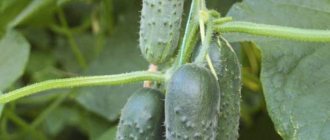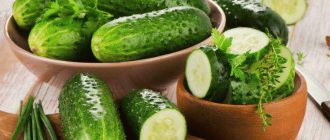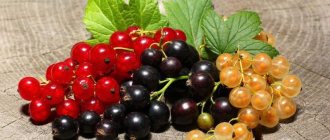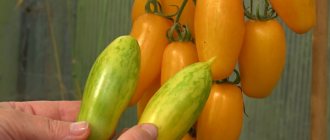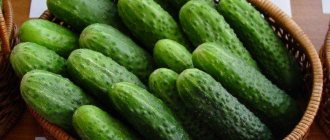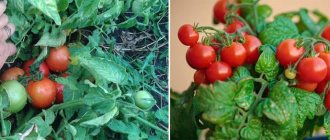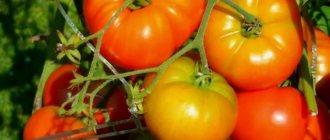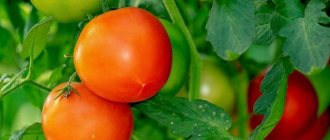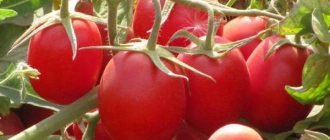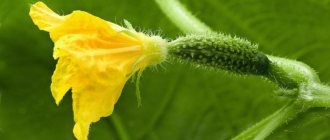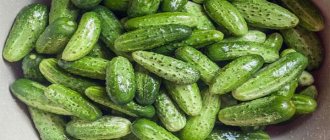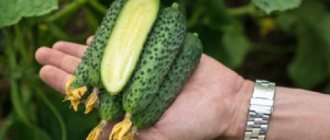Growing in greenhouses: which varieties are best suited for the Urals
The climate of the Urals is far from ideal for heat-loving cucumbers, but among the rich variety of varieties you can choose suitable ones. Considering the short duration of warm summers, it makes sense to plant early and mid-ripening hybrids.
To ensure that we have a good harvest, we will choose at least 4–5 hybrids. By mixing different varieties in plantings, we increase productivity, as we enhance cross-pollination of cucumbers.
Nezhinsky cucumbers are very popular among vegetable growers in the Urals . This variety is good for both salads and pickles, and it bears fruit until autumn. Breeders offer the following hybrids for growing in greenhouses.
Table: the best varieties of self-pollinating cucumbers for the Urals
| Hybrid name | Ripening period | Direction of use |
| Altai gherkin F1 | early ripening | salad |
| Cupid F1 | early ripening | pickling |
| The Fab Five F1 | early ripening | universal |
| Emelya F1 | mid-season | salad |
| Emerald Family F1 | early ripening | canning |
| Masha F1 | early ripening | canning |
| Moscow evenings F1 | early ripening | universal |
| Chernomor F1 | early ripening | canning |
| Ecole F1 | mid-early | canning |
These hybrids are parthenocarpic, that is, they do not require pollination by insects. They have proven themselves well for breeding in closed ground conditions.
Hybrids Chernomor and Ekol are zoned in the Urals.
Photo gallery: cucumber hybrids for growing in greenhouses
Cupid F1 is suitable for greenhouses and open ground. High-yielding Magnificent Five F1. High-yielding hybrid. The period from germination to fruiting is 38–42 days. Emelya F1 is characterized by cold resistance and productivity. From germination to fruiting 40–45 days. Emerald family F1 has high productivity, disease resistance, good taste. Masha F1 tolerates temperature changes well. The period from germination to fruiting is 36 days. Chernomor F1 is recommended for fresh consumption, for canning and pickling. Ecole F1 is a productive gherkin-type hybrid. From germination to fruiting 42 – 45 days
Varieties and hybrids of cucumbers for planting in open areas
Cucumbers for open ground for the Urals - here you need to choose early varieties that are resistant to cool climates, suitable with the following names:
Vyugovey F1
An early ripening, self-pollinating hybrid, yields well, suitable for growing in open and closed spaces. The fruits are bright green, with light spines, 8-11 cm long. Vyugovey F1 is resistant to downy mildew and mosaic virus. Cucumbers are aromatic, have good taste, and are suitable for salads and preparations.
The seed material of this hybrid can be planted as seedlings or directly into an open garden bed. At home, the seeds are planted in separate containers in early April. In early June, after the threat of frost, seeds can be sown directly into the ground.
An early ripening variety, it is distinguished by the absence of bitterness. Cucumbers have a high marketability, can be transported over long distances, and greens do not turn yellow. The plant is resistant to a number of diseases. The variety can be grown in open and closed areas.
Multifruit
A new early ripening variety - obtained as a result of the work of domestic breeders. The fruits are intense green, medium-tubercular with light spines. Fruiting lasts from June to August. The length of the greens is 8-12 cm, the flesh is dense, aromatic, crispy. Variety type
Note! The multifruit does not suffer from powdery mildew, can withstand cold weather, and grows well in the shade. Greens are used in cucumber salads and preparations.
Growing in open ground
Urals gardeners are offered a large selection of zoned early and mid-ripening hybrids and varieties of cucumbers. They are specially bred for short summer conditions, so they are able to withstand heat, prolonged rains, cold snaps and at the same time bear fruit well. The varieties and hybrids offered below are characterized by a short ripening period: one and a half months from germination to the first fruits.
Table: varieties and hybrids for growing in open ground
| Name of variety or hybrid | Ripening period | Direction of use |
| Altai | early ripening | pickling |
| Vector | mid-season | canning |
| Vyaznikovsky 37 | early ripening | pickling |
| Dean | mid-early | canning |
| Squad F1 | early ripening | universal |
| Baby crane F1 | early ripening | universal |
| Elegant | early ripening | salad |
| Magician | mid-season | pickling |
| Bush | early ripening | pickling |
| Pet | early ripening | canning |
| Movir 1 F1 | early ripening | salad |
| Muromsky 36 | early ripening | pickling |
| Reliable | early ripening | pickling |
| Fontana F1 | early ripening | pickling |
| Firefly | mid-season | canning |
These varieties and hybrids are bee-pollinated, with a predominantly female type of flowering. They are characterized by a combination of unpretentiousness, productivity and reliability.
What is the difference between a variety and a hybrid? Hybrids are more productive, but do not form full-fledged seeds. Hybrids are designated by the F1 icon on the packaging.
The most productive varieties of cucumbers for the Urals
Baby
A cultivar that has proven itself well in the conditions of the Urals. It belongs to the category of early ripening varieties; it requires pollination, so it is better to grow it in open ground. The harvest is always stable, early and excellent. Usually, a little more than a month passes from the moment the shoots appear, and it will be possible to harvest the first harvest of cucumbers.
The fruits are tasty, have a typical crunch, and are great for cutting into a salad or for canning. The harvest is quite high; from one plant you can easily collect about 6 kg of fruit. Each fruit has tubercles on the surface, whitish pubescence, reaches a length of 9–11 cm and a weight of 100–110 g.
Advantages include compactness, suitability for frequent planting, low maintenance requirements, and resistance to many diseases.
Photo: Baby.
Firefly
Perfectly suited for the conditions of the Urals and for cultivation in open ground. An early variety, pollinated by bees, produces the first fruits a little later - 50–55 days from the moment of mass shoots.
This plant is quite active-growing, does not tolerate thickening, and produces mostly female flowers with the ovary arranged three in a bunch. The shape of each cucumber resembles a cylinder, the color is darkish-greenish, and there are light stripes on the surface. The tubercles are noticeable, the ribs are also clearly pronounced, there is whitish pubescence and there is almost never any bitterness in the taste. The length of each specimen is about 11–12 cm, and its weight reaches 80–95 g, which allows you to collect up to 7 kg of fruit from each plant.
Photo: Firefly.
The advantages include always stable yields, low demands on growing conditions, which is why planting in open ground is ideal, and resistance to temperature changes. The variety requires watering in the evening and only at the root.
| Important. An important feature is resistance to powdery mildew, which every person appreciates. |
Muromsky 36
Fruitful, ideal for the conditions of the Urals, where Muromsky 36 can and should be grown. Its characteristic feature is only 35–45 days from the moment of germination to harvest, which is exactly what is relevant for the Urals.
It is better to grow in open ground, since Muromsky 36 requires pollination. Cucumbers have the shape of an egg, but more often, however, they have an elongated oval shape. Small and sparsely located tubercles are clearly visible on the surface of each fruit.
Photo: Muromsky 36.
The length of each specimen can reach 7–9 cm, and the weight reaches 75–80 kg, which allows you to collect up to 6.5 kg of fruit from each bush, of course, with good care and on nutritious soil, since the variety is very demanding for this.
The undoubted positive qualities include the fact that Muromsky 36 is resistant to cold, is not afraid of powdery mildew and even bacteriosis. It can bear fruit until the middle of the last month of summer.
Zyatek
It is perfect for the conditions of the Urals and grows quietly in open ground, as it is not demanding in terms of growing conditions.
Belongs to the category of early ripening, you won’t have to wait long for the first cucumbers; usually, after the appearance of mass shoots on the soil surface, only 43–46 days pass before harvesting.
| Important. It can be grown both in open ground and in a greenhouse, since it is a parthenocarpic cucumber and does not need bees to form a crop. |
Speaking of the harvest: it can exceed the standard 5.5 kg of fruits per bush, since its fruits reach a length of about 12–16 cm and a width of about 4 cm, and their weight often exceeds 100 g.
Photo: Zyatek.
The undoubted advantages include the fact that the skin of vegetables never tastes bitter and has a small number of tubercles with barely noticeable spines that do not interfere at all. The color of each fruit is rich green, and their characteristic feature is light stripes on the surface. In the axils of each leaf blade, from 3 to 7 cucumbers can form, and sometimes more.
You can collect cucumbers of all the varieties described above both at the pickle and gherkin stage, and, if desired, wait until they reach their maximum size. They do not taste bitter and form a fairly strong root system, which allows you to reduce the amount of watering to a minimum. On good, nutritious soil they can bear fruit until mid-August and even longer.
How to properly plant cucumbers in a greenhouse
Cucumber is a heat-loving plant, and in our area the period favorable for cucumber is very limited: from the second ten days of June to the second ten days of August. However, there is no guarantee that the summer will be warm. Therefore, in order to provide yourself with a harvest, it is preferable to cultivate cucumbers in a greenhouse.
The landing process consists of several mandatory steps:
- greenhouse preparation;
- soil preparation;
- preparation of planting material.
Greenhouse preparation
Experienced gardeners recommend a polycarbonate greenhouse. It has a number of advantages:
- It is more wear-resistant compared to other types of greenhouses.
- In a polycarbonate greenhouse it is easier to create an optimal microclimate for plants: there are no cracks, and therefore no drafts, no problems with ventilation, and the leaves do not get sunburned.
- Polycarbonate can be left for the winter.
Work in the greenhouse begins in the second half of April. To prevent diseases, we disinfect the greenhouse completely (we treat the frame and walls with a bleach solution) and replace the soil: remove the top layer of soil 10 cm thick and take it out into the sun.
Preparing the bed
We are preparing new soil for cucumbers.
- Option one: add compost or manure up to 10–15 kg per square meter.
- Option two: 6 parts peat, 2 parts humus and 2 parts wood soil.
We form beds and add a glass of wood ash to each. We can plant both seedlings and seeds in beds prepared in this way at the right time.
Let's warm up the soil for cucumbers. For this purpose, we place metal arcs a meter high on the beds and cover them with agrofibre and film for several days. We remember that cucumbers are planted at an air temperature of +20ºС, and the soil temperature is also needed not lower than +20ºС. For more rapid warming up, you can water the beds with warm water and EM solution.
EM are effective microorganisms. Adding an EM solution to the soil promotes its earlier revitalization and enrichment.
Preparing seedlings
We planted the seeds in cups 3 weeks ago, and now we are gradually accustoming the seedlings to fresh air and sunlight. On the first day, we take the seedlings into the greenhouse for 2–3 hours. Every day we increase the time the seedlings stay in the greenhouse by 1–2 hours. Seedlings prepared in this way will suffer less from differences in night and day temperatures.
Disembarkation
When the soil warms up to the desired temperature, we begin planting seedlings. By this time, our cucumbers have 3–5 true leaves. In order not to thicken the planting and use the space rationally, we plant cucumbers according to the following scheme:
In the greenhouse, the distance between rows is 160 cm and 35 cm between plants in a row
Disembarkation instructions:
- We remove the film from the garden bed.
- We make a depression the size of a glass in the ground.
- Place a pinch of Kemira at the bottom of the hole.
- We water the seedlings with warm water and carefully remove them from the glass, trying not to damage the trunk and roots.
- We lower the seedlings into the hole and carefully compact the soil. Seedlings should grow vertically.
- We water everything with warm water at the rate of 4 liters per 1 square meter. m. Then we don’t water it for a week.
At night, cover the beds with film. We ventilate the greenhouse daily, avoiding drafts. After two weeks, feed with liquid mullein (1 liter of solution per 20 liters of warm water).
Popular varieties and hybrids in 2018
Cucumbers for the greenhouse - varieties best for the Urals:
Arina F1
A hybrid with increased productivity, for planting in greenhouses, greenhouses, and open areas. The plant is powerful, with rapid development, quickly adapts to a cool climate. Even with a lack of sunlight, the side shoots develop well. Plants are resistant to a number of major diseases.
The cucumbers are bright green in color, with large tubercles and light spines, 15-17 cm long. The taste is good with characteristic freshness without bitterness, the harvest can be used for cooking, pickling, pickling.
Note! When to plant cucumbers in a greenhouse in the Urals? The Arina hybrid is first planted as seedlings in the second half of April, and in greenhouses planting is carried out from May 15 to May 25. Plants are placed in open beds from June 5 to June 10.
In closed structures per 1 sq. m there are 2-3 plants, in open areas 3-4 seedlings.
Karapuz
Bunch mini-gherkin with female flowers. From 2 to 5 ovaries are formed in the nodes. The Karapuz variety has a long fruiting period, the shoots constantly grow, forming new ovaries. The plant actively develops even in moderate temperatures. The greens are slightly tuberculate, up to 8 cm in diameter, with a rich green hue. The fruits practically do not outgrow, the taste is good, cucumbers are used for fresh food and preparations.
Note! Plants of this variety are not susceptible to mosaic virus, powdery mildew, bacteriosis, or olive spot. Seeds should be planted in the greenhouse after May 15, in ordinary beds in early June.
Dynamite F1
A new powerful hybrid that thrives in low sunlight and is highly productive. The plant is bred for harvest in greenhouses, hotbeds and balconies. The harvest ripens early, 45-50 days are enough. The fruits are tuberous, weighing up to 130 grams, with a characteristic cucumber taste without bitterness. Dynamite F1 is resistant to major diseases; seeds are sown for seedlings after April 20. If planting is planned immediately in a greenhouse, then sowing is carried out in mid-May.
Important! To get a rich harvest of vegetables in the Urals, seeds of the Siberian series or the Ural summer resident variety are suitable.
How to plant cucumbers in open ground correctly
The optimal air temperature for cucumber is +20 +24ºС during the day and +16 +18ºС at night. At +12 °C and below, the roots stop functioning and the cucumbers lose their ovaries. If the temperature drops to + 5 °C, the cucumbers simply die. Thus, the primary task becomes to provide cucumbers with protection from the cold. In practice, this can be done using one of the following methods:
- landing under film;
- planting in a warm bed;
- landing in a barrel.
Fitting under film
You can plant under the film already from the second half of May. First of all, we choose a place for future beds. Cucumbers require a well-lit place, protected from the wind, and away from groundwater. We remember about crop rotation: we do not plant cucumbers in the same place for two years in a row. There is no need to plant cucumbers where last year you grew melons, squashes, and zucchini. Onions, tomatoes or potatoes are considered good predecessors for cucumbers.
Cucumbers need loose soil with neutral acidity. We prepare the place for sowing: we loosen the soil and form a bed with a rake 70 cm wide. Then we install metal arches and stretch the film over them. In this way we warm up our beds for several days. When the ground warms up, we plant cucumbers. The technology is simple:
- Using a rake, we draw two neat grooves 4 cm deep along the edges of the bed.
- We water them with warm water from a watering can.
- We place the seeds in these grooves 10 cm apart and cover them with soil.
- We water the garden bed generously with warm water and cover the crops.
For reliability, we make a two-layer shelter: closer to the plants - covering material, with a film on top. We are waiting for the shoots. We do not open the bed until they appear. When the cucumbers hatch, we thin out: we remove excess shoots, leaving 20–25 cm between healthy plants. During the day, we remove the film, and at night we cover the cucumbers with both film and covering material. In hot weather, we protect young shoots from the hot sun. In case of cool weather during the day, we remove the film for a while so that the crops do not suffocate, leaving them under the covering material. It provides a temperature 3-4 degrees higher than outside.
Without film, cucumbers can be planted in open ground no earlier than the second ten days of June, when warm weather sets in and the threat of night frosts has passed.
Growing cucumbers in a warm bed
A warm bed is the most convenient way to grow cucumbers in our conditions. It's cheap, environmentally friendly and practical. There are many options for preparing a warm bed, but the principle is the same: biofuel below, about 20 cm, and the same layer of earth on top. The technology for making a warm bed is simple. At the beginning of May, we pour manure according to the size of our future bed, make sides from boards on the sides and fill the resulting box with soil. We cover it with film and let our bed warm up for two weeks. When manure “burns,” it releases heat and carbon dioxide, which is beneficial for cucumbers.
Be careful not to burn the cucumber roots. The soil layer must be at least 20 cm.
Such a bed “burns” for about a month, then its temperature gradually decreases. The beauty of a warm bed is that any organic material can be used as fuel: manure, grass, sawdust, hay. This is done simply:
- We outline the dimensions of the future bed and remove the top layer of soil (about 20 cm).
- We place thin branches in the resulting depression for drainage and pour in everything that will rot.
- Pack tightly. The result is a “pillow” 20 cm thick.
- To get rid of pests, water with a hot solution of potassium permanganate.
- Cover the “pillow” with a layer of removed soil. To fertilize the soil, add compost and humus. For acidic soil, use chalk, dolomite flour with lime or wood ash.
- Cover with film and wait two weeks.
It’s convenient to make warm beds in wooden boxes like these
At the end of May or even from the second half of May, you can plant seedlings or sow seeds in such a warm bed. The bed provides enough heat to protect the crops from May frosts. After germination, we open our garden bed in the morning and close it in the evening. We continue this way as long as there is a danger of frost. Then we remove the film until August. This month we reduce watering and insulate the cucumber beds with film at night. After a short-term cold snap, the warmth may return, and then the cucumbers will continue to grow and bear fruit. You can pick cucumbers under the film throughout August.
Growing cucumbers in a barrel
One option for creating a warm bed is growing in a barrel. A layer of drainage from branches is placed in a 200-liter old barrel without a bottom and organic waste is placed: peelings, food waste, tops, grass from the site, filling the barrel by a third. Manure and fertile soil are poured on top. Leave 15–20 cm to the edge. Then they proceed according to the already familiar scenario: cover with agrofibre and film, warm the ground, water, plant seeds and wait for the harvest. 4–6 seeds are planted in one barrel.
Growing cucumbers in a barrel: environmentally friendly, economical, aesthetically pleasing
Video: growing cucumbers in a barrel
Features of caring for greenhouse cucumbers in the Urals
Even in the Southern Urals, greenhouse cucumbers have to be grown using seedlings. Since most modern varieties are actually hybrids, it is necessary to purchase seeds of breeding quality. Their packages indicate the timing of all major cultivation operations.
Late-ripening varieties of cucumbers
The tropical origin of the cucumber determines its increased requirements for the microclimate. At temperatures below 12 degrees Celsius, plant pollen dies, and already established green plants stop growing. Air humidity must be maintained at a level of at least 90%. The weather in the Urals is unstable, so greenhouses are ventilated in hot weather and kept closed in bad weather.
Water for irrigation must remain in the greenhouse for at least a day, where it is warmed, otherwise the fruits die and powdery mildew settles on the leaves. To enrich the air with carbon dioxide, place a container with manure diluted two-thirds with water in the greenhouse. During fermentation, manure slowly releases carbon dioxide, which plants will convert into sugar and other substances for growth and fruit filling.
Cucumber loves care and responds to it in any climatic region of the country. The correct selection of varieties, daily checks of plant health, timely agrotechnical operations, and careful harvesting of greens are guaranteed to provide a caring owner with a vitamin salad.
Useful tips
To get a harvest, you should take into account the key characteristics of this vegetable and not lose sight of the weather features in our region, namely: unpredictability, the possibility of frosts until mid-June, periods of long cold spells in the middle of summer. That's why:
- We choose early-ripening zoned hybrids, which are characterized by resistance to various adverse weather conditions.
- To get early cucumbers, we plant them not with seeds, but with seedlings.
- We protect the cucumber beds from possible frosts.
- We provide cucumbers with a temperature not lower than +18ºС.
Otherwise, the methods of cultivating cucumbers in the Urals do not differ from the basic rules for caring for this popular vegetable.
Characteristics of medium-ripening varieties for greenhouses in the Urals
This category of greens includes self-pollinating and parthenocarpic hybrid forms that can begin to bear fruit in Ural greenhouses in 46-50 days. Experienced gardeners recommend paying attention to the following varieties:
1. “Champion” is a weakly climbing indeterminate parthenocarpic with excellent characteristics:
- bears fruit on the 46th day;
- duration of fruiting in a greenhouse – until November;
- salad greens;
- the fruits do not outgrow, reaching 12 cm in length and 90 g in weight.
2. The “Chinese disease-resistant” hybrid can produce cucumbers already on the 50th day. Representing a powerful vine, it can be molded into 1 stem. It bears fruit with 30 cm salad-type cucumbers. Absolutely unpretentious to lower temperatures and lighting, resistant to diseases typical of cucumbers.
3. “Claudia” is a shade-tolerant parthenocarpic with a friendly return that occurs on the 47-50th day. With a bunched ovary - 3 or more greens, good climbing, which ensures excellent yield - 20 kg per 1 m². Requires daily fruit harvesting. Having a sweetish pulp, it is most suitable for salads.
4. “TSHA 2783” - ideal for winter greenhouses, since it is shade-tolerant and tolerant of temperature fluctuations, and is resistant to rot. It has a high yield - more than 25 kg per 1 m². The greens are salad greens, white-thorned, and grow to 20 cm.
5. “Zozulya” is a weakly branched hybrid that does not require special formation. Distinctive features of the variety:
- tolerant to weather conditions;
- productive - 8-20 kg per 1 m²;
- the fruits are slightly curved, white-thorned, and have good keeping quality;
- universal in use;
- with long-term fruiting.
The best varieties of cucumbers for open ground for the Urals and Siberia
Most cucumbers prefer milder and warmer climates. But still, there are varieties adapted to the harsh conditions of the Urals and Siberia.
Altai early
The early variety is resistant to low temperatures and is notable for its very hardy vines. Cucumbers grow of medium size, up to 90 g. They do not turn yellow and do not change taste during storage and transportation.
baby crane
Among the tender, sweetish cucumbers, hollow ones are almost never found. Under favorable conditions, fruiting extends until significant autumn frosts.
Barguzinsky sable
The cold-hardy hybrid is perfectly adapted to open ground. Its main advantages are stress resistance and resistance to typical cucumber diseases.
Blizzard
The ultra-early variety is ideal for cold regions, but prefers seedling cultivation. For a stable harvest, mineral supplements are needed.
Review of early ripening cucumbers recommended for Ural greenhouses
Parthenocarpic varieties that are capable of forming ovaries without pollination are best suited for cultivation in greenhouses in the Urals. This category of varieties with an ultra-short development period includes cucumbers that manage to grow and begin to bear fruit in less than 45 days from germination. According to reviews from Ural gardeners, excellent results were shown:
1. “Cupid” is an F1 hybrid, among the main advantages of which the following should be highlighted:
- 37-45 days development period;
- spiny, highly pubescent relief and fusiform shape;
- weakly branched lashes;
- compact size of greens – up to 10 cm and 90 g;
- bunch type of ovary – up to 4 pcs;
- yield level -14-25 kg per 1 m²;
- tolerance to fungal infections typical of greenhouse cucumbers.
The ultra-short growing season and resistance to cold make “Amur” attractive for cultivation in greenhouses in the Urals, making it possible to plant it in 2-3 times per season.
During the season, “Amur” cucumbers can be planted 2-3 times
2. “Arina” is a parthenocarpic, low-light-tolerant hybrid of the F1 series. It has strong branching and requires pinching. Capable of tying 1-2 white-thorned greens in a knot. It is not affected by mosaic, spotting and other diseases common in cucumbers.
3. “Valaam” - cold-resistant parthenocarpic with a bunched ovary - 3-6 black-thorned fruits. Characterized as:
- ultra-early – 38-day development period;
- powerful, but with limited growth of stepsons;
- productive - 13 kg per 1 m²;
- universal - for salad and pickling;
- small-fruited - up to 6 cm in length and no more than 3.5 cm in diameter.
Attention! Due to its cold resistance, this variety is able to bear fruit in a film greenhouse until frost.
Other highly productive early hybrids intended for cultivation in the Ural greenhouses include “Mazai”, “Voyage”, “Shik”, “Okhotny Ryad”.
Cucumbers "Arina"
